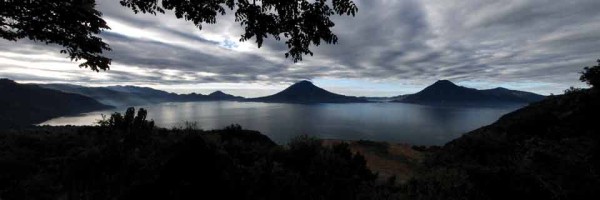Lake Atitlán: Up Close and Cozy
I did not pick the name “Lake Views” for this column, but it stuck nonetheless. So I should probably make the lake my topic at least once.
There is no counting the number of times—it is too many—that I have read that Aldous Huxley (1894-1963) called Atitlán the world’s most beautiful lake. He would know, being one of the best-traveled men of his day. Huxley’s opinion has been translated into French, German, Dutch, Italian, Portuguese, Korean, Czech, Norwegian and, of course, Spanish. And these are just the ones I know about.
So why is it always Huxley? Bill Clinton came here in 1998. And while I recall his visit (and his failure to buy my book or request my autograph), I do not remember him opining on the lake. No written account of his and Hillary’s visit seems to include any mention of the lake.
If you are retired here, and dislike development, and are not dependent on tourism, this is a good thing.
Enough, maybe, to make you vote for Clinton if he makes a comeback. (Nixon did, so don’t laugh.)
But if you are like the rest of us living in Panajachel—the tortilla makers, típico hawkers, nightclub musicians, beer merchants and hack column writers—then the lake’s reputation is important to you. Too important, I say, to leave it to some guy who could write well enough, but who requested LSD on his deathbed and did some other “experimentation” of that ilk. I say that, from now on, all visiting chiefs of state must weigh in. That way we do not have to perennially depend on what has become a hackneyed quotation from a dubious source.
That all said, I agree with Aldous. I have not seen as many lakes as he had, having only visited 21 countries in my life. So, my problem may be sampling error. But to my eye, Atitlán is indeed in a class by itself. There are three classes: lakes that are not beautiful, lakes that are, and Atitlán. One in the second category is Lake Tahoe, in Nevada (pues, Nevada shares it with California, pues, but we Nevadans still call it Nevadan). As a kid I was awed by Tahoe, whose beauty is no sham. Yet Atitlán makes it look like one of those little fake ponds at Disney’s Magic Kingdoms. You know—the ones they fill with Sani-Flush so that the water matches the blue ink in fairy-tale books, and so that you cannot see those messy pipes at the bottom. (Nope, we mustn’t have any of that at the world’s happiest place.)
My own first “lake view” of Atitlán came in 1988, at the end of a long drive all the way from the U.S. While tooling down the 7-kilometer road from Sololá to Pana, I had to pull over, get out and gawk. An elderly Maya was walking up the road, panting some. He stopped and told me the names of the volcanoes: Atitlán, Tolimán, San Pedro and little Cerro del Oro, where gold is rumored to be hidden.
I have seen the lake tens of thousands, or hundreds of thousands, of times since this introduction took place.
And every time is a little like the first look; the magic lingers for a lifetime. It is the pause that always refreshes, something that never gets old.
While I agree that the lake is “young” (estimates range from 4,500 to 85,000 years), I do not accept the fashionable explanation that it is the caldera of a mega-huge collapsed volcano. I could give many reasons for this, but one is that much of the slope ringing the basin is sheathed in very young sediments. Therefore, Atitlán must, very recently, have filled the whole basin. Or it was contiguous with an even larger water body. (Is there anyone in Readerland up for a formal debate?)
Atitlán is Central America’s deepest lake, meaning it is quite voluminous; it has about 90 times as much water as another lake, one that it is often confused with (Amatitlán), has. This means that while Atitlán cannot go on being polluted forever, it can take a few extra hits. With Amatitlán, the wakeup call came decades ago and was ignored. With Atitlán being so much bigger and revealing its ailments in a more modern era, we have a snooze button ahead of the wakeup.
Now those of us living in the Atitlán basin are pretty varied. We are Mayas, ladinos, expats, snowbirds and tourists. Only one thing unites everyone: the need to protect the lake. To the community’s credit, almost everyone jumped up in 2008 to hit the snooze button: the cyanobacteria bloom was manifest in that year. The wakeup call, such as it was, was the blow to the local economy caused by the negative press over the pollution.
Hurricane Agatha undid some of the work that Felix Churunel, Sid Eschenbach and other local leaders put in place and continue to promote. But the stewardship of the lake has today become a household imperative. People are recycling more, digging septic systems and distinguishing the real polluters from nonpolluters. This distinction was at times briefly lost in the initial hysteria following the 2008 bloom.
It was then that five major hotels—Del Lago, Riviera, Atitlán, Don Rodrigo and Don Moisés—called a press tour to prove that their own effluent solutions were flawless. And most of them have entire nurseries that use all their blackwater. They do not pollute at all.
So what is an Atitlán “lake view” like today? From afar, beautiful as always. But up close, too. I recently took my father-in-law kayaking from the beach in San Antonio Palopó. I will not claim that the water I saw was ready to drink, but it was crystalline, and you could see several meters into the depths. So, if you are staying away because you worry about the view, then come back.
